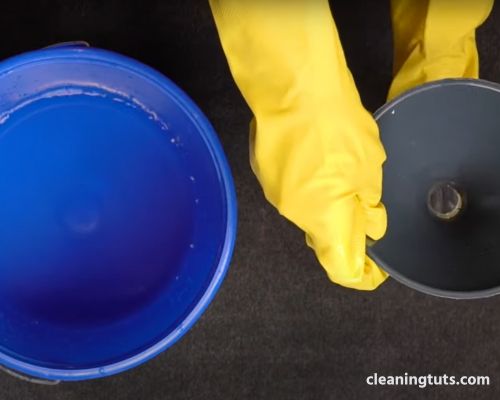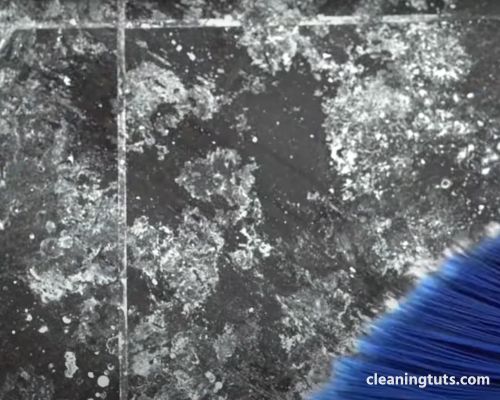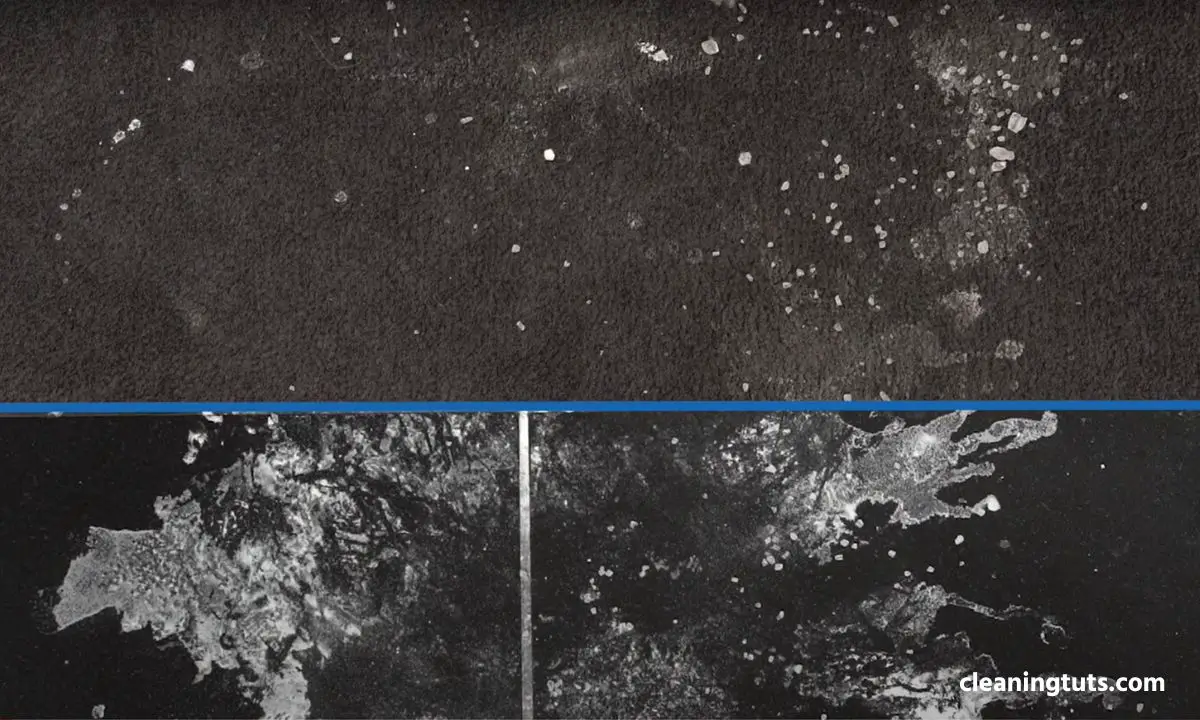The Ultimate Guide to Removing Salt Residue from Floors
As lovely as it is to walk in the snow, it’s a pain to clean up salt from your boots afterward. While rock salt is your bestie on the road clearing your pathway, it’s your enemy at home threatening to damage those newly installed floors.
So, how to remove salt residue from floors?
Salt increases vehicle safety on harsh winter terrains by melting the ice. You’ll find either rock salt or calcium chloride being used for this purpose. But this can harm residential flooring by corrosion, stains, health issues, and even discoloration.
You need to take steps to get rid of salt residue if you want your floors to last their due time. And that’s what I’ll explain here. Let’s get into the discussion.
How to Remove Salt Residue from Floors?
In this discussion, I’ll reveal some handy tricks and tips to remove salt residue from different types of floors so that their natural looks get preserved. From tile to hardwood to laminate, I’ll cover various easy-to-follow methods that use everyday household items and store-bought products.
Whether it’s crystalized rock salt or some form of calcium chloride particles blocking those crevices in your room’s corners, there’s a definite way to clear them out. But before you do that, there are a few things you’ll need to prepare.
Preparing to Remove Salt Residue
Before you start shoving and scrubbing up the salt, you must realize why you’re doing this. Removing salt residue is essential because it can ruin your entire floor’s quality and aesthetic.

Since salt is naturally corrosive, it can eat away at hardwood and metal surfaces. It can even ruin finishing layers on shiny laminate and cause scratches upon movement.
If your home has pets and children, it’s even more crucial to not let salt sit on the floors. Since it’s used on the roads, contamination agents like dirt, pollutants, and harmful chemicals can be mixed into them.
This can lead to health reactions in a negative way.
Gathering Supplies
So, as part of your preparation to get things done, you’ll need to gather the supplies and materials needed. Depending on your flooring type, you’ll need different supplies.
For instance, when dealing with hardwood floors, you’ll need a microfiber cloth or mop. But when you’re working on tiles, you need to use a brush with soft bristles.
Again, the cleaner product you use will be based on the type of material flooring installed. Concrete cleaning products can’t be used for cleaning wooden floors.
You’ll need a vacuum in most cases. A bucket, some warm water, and a spray bottle are a must on the list.
Keep in mind that wearing some form of protective gear is part of the process too. Remember gloves and eye protection, as salt can cause instant irritation if your eyes come in contact with it.
Removing Salt Residue from Different Floor Types
You can only work the same way for some types of flooring. So, here’s a set of instructions based on different floors.
Removing Salt Residue from Tile Floors
Tiles are a popular choice for both homes and commercial buildings. They’re great value for the money and require minimal maintenance. But things can get tricky when salt is involved.

Since tiles have grouting lines, the crevices are more prone to getting salt accumulation. Some tiles are textured, and they hold onto particles a lot more than other types of flooring. So, you need a strong hand to clean all this up.
You can remove salt from these floors by vacuuming first, followed by a high-quality tile-cleaning solution. Use a soft-bristled brush or mop dipped in the cleaning solution to scrub the floors.
Then you’ll have to rinse thoroughly to prevent any soap residue from remaining. You need to avoid any sort of acidic or abrasive cleaners, as those can damage the tile surface.
Removing Salt Residue from Hardwood Floors
Hardwood floors are popular not only due to their aesthetic appeal but for their durability and ease of maintenance. These floors have a variety of finishes, colors, and types that make them perfect for a cozy home look.
But hardwood is heavily prone to salt damage and stains. To remove salt from such flooring, you’ll need to vacuum and sweep first. This should be followed by using hardwood floor cleaners.
Dish soap solutions for hardwood floors are also a good option. But ultimately, you need to avoid any harsh chemical-based cleaners that can damage the wood.
Just mop the floor after applying the cleaning solution. The trick is to mop along the grain of the wood and not against it.
You can apply a floor polish designed specifically for hardwood to improve the shine and texture afterward. This will also act as a protective layer against the salt getting to the finish.
Removing Salt Residue from Concrete Floors
Compared to hardwood, concrete is less expensive and more durable. But that doesn’t mean it’s above harm from salt getting dragged all over it.
In fact, you need to do more than usual to clean the salt off these floors. Scrubbing vigorously with a tough brush is one of them.
The first step is to sweep and loosen up the dirt and salt rocks. Then you’ll need to mix some warm water with mild dish soap. You can switch this out for a pH-neutral soap liquid or a commercial concrete cleaner.
And then you’ll have to scrub like your life depends on it. Even though this may seem too much, concrete has a very hard surface making it fit for push broom usage and even more deep cleaning.
So, don’t worry about damaging the floor as long as you don’t use any strong acids. Make sure you rinse it with warm water properly to get sparkly results.
Preventing Salt Residue Build-up
There are ways you can minimize the effect of salt on your floors and also prevent messes in the home. Some of these simple tips involve changing up a few habits, while others are more technical.
The first tip I have to offer is to use a salt-neutralizing cleaner. These cleaners are formulated to target salt residue and remove it from floors.
The second tip is to place mats at entryways outside and inside the home. By doing this, you’re encouraging everyone to clean their boots before entering and also minimizing the dirt being dragged inside.
Taking off the boots as soon you get inside can also be a good strategy. And the third tip I’d like to mention is to maintain proper humidity levels inside.
When the inside air is too dry, the salt can solidify and accumulate faster than usual. The best way to maintain humidity inside the home is by using a humidifier. It adds moisture to the air and prevents dryness.
Frequently Asked Questions (FAQs)
1. How does salt residue damage floors?
Floors can get damaged by residual salt via corrosion and stains. Solidified salt can scratch surfaces and also encourage mold growth on wood floors. When chloride ions penetrate the grout, it makes the flooring uneven and leads to cracks.
2. Can I use vinegar to remove salt residue from floors?
Yes, vinegar can be used to remove salt residue from various types of floors. As vinegar is a mild acid that can effectively dissolve salt deposits, it’s a great option to help remove them from various surfaces.
3. How often should I remove salt residue from my floors?
This mainly depends on the type of flooring being used in your home. For tiles and laminate, it’s alright to clean the salt every few days. But if you have hardwood floors, I’d suggest cleaning them up promptly.
4. What causes salt residue on floors?
When roads get too snowy, trucks are used to deposit large amounts of salt on their sides. And when you walk home from these roads, your shoes and clothes drag salt residue back inside. Over time this can accumulate and damage any type of flooring.
5. Is it safe to use a steam mop to remove the salt residue?
As long as you’re not using too much steam or excessively high temperatures directly, this is quite safe to use for salt expulsion.
6. Can salt residue cause discoloration on floors?
Yes, they actually can. Salt reacts with chemicals and pollutants that can eventually wear off the protective layer and polish on your floors. Then the colors can get all messed up.
7. How long does it take for the salt residue to damage floors?
The time it takes to damage the floors can vary, and if you’re not careful, it can even warp and rot the floors before you know it. For tiles, this can take longer. But for laminate and wood, it takes just a few days. Concrete floors will wear down after a few weeks, and they will definitely be visible.
8. Can I use baking soda to remove salt residue from floors?
Yes, you can use baking soda to remove salt residue from floors. Since this is a natural abrasive that reacts to breakdown salt, it can easily lift up stubborn and solidified deposits from the floor.
Can the Methods for Cleaning Warehouse Floors Be Applied to Removing Salt Residue from Floors?
When it comes to removing salt residue from floors, it’s important to consider using the same cleaning warehouse floor tips. Using a combination of sweeping, mopping, and scrubbing can effectively eliminate salt buildup. Additionally, using a neutral floor cleaner and hot water can help dissolve and remove salt residue from the floors.
Conclusion
Although it can be distressing to find your floors covered in salt crystals, it’s only a seasonal problem that needs prompt attention. And if you know how to remove salt residue from floors properly, it won’t be a big deal to handle. All you need is the right cleaning gear and a few habitual changes to protect your home.
This article helps you figure out the best way to handle the situation. From cleaning up preparation to the prevention of the problem, I’ve covered key points and hacks to make it easy for anyone.
And while salt residues can be troublesome, a damaged floor is much more of a headache (and an expensive one) to deal with. That’s why it’s best to do everything you can to prevent the salt from taking its toll in the first place. Prevention is better than cure, right?

